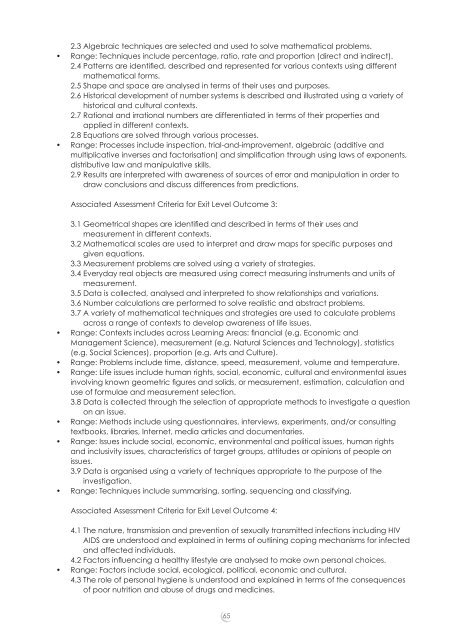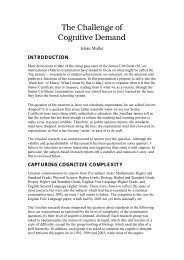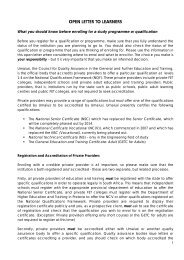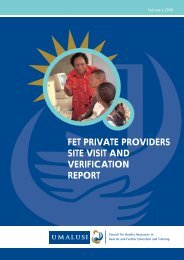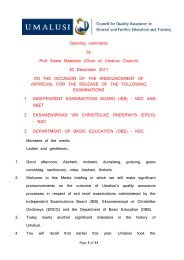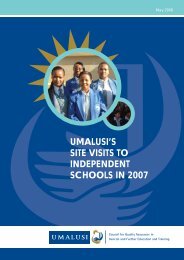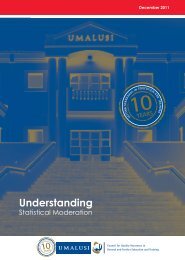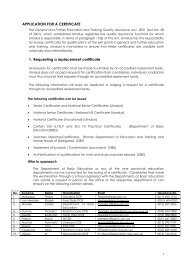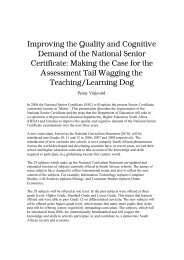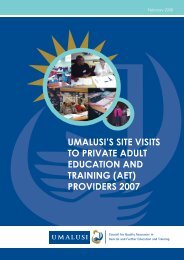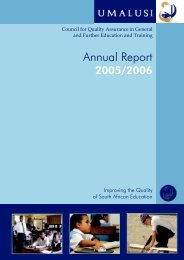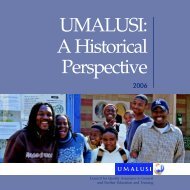Inspecting the Foundations - Umalusi
Inspecting the Foundations - Umalusi
Inspecting the Foundations - Umalusi
You also want an ePaper? Increase the reach of your titles
YUMPU automatically turns print PDFs into web optimized ePapers that Google loves.
2.3 Algebraic techniques are selected and used to solve ma<strong>the</strong>matical problems.• Range: Techniques include percentage, ratio, rate and proportion (direct and indirect).2.4 Patterns are identifi ed, described and represented for various contexts using differentma<strong>the</strong>matical forms.2.5 Shape and space are analysed in terms of <strong>the</strong>ir uses and purposes.2.6 Historical development of number systems is described and illustrated using a variety ofhistorical and cultural contexts.2.7 Rational and irrational numbers are differentiated in terms of <strong>the</strong>ir properties andapplied in different contexts.2.8 Equations are solved through various processes.• Range: Processes include inspection, trial-and-improvement, algebraic (additive andmultiplicative inverses and factorisation) and simplifi cation through using laws of exponents,distributive law and manipulative skills.2.9 Results are interpreted with awareness of sources of error and manipulation in order todraw conclusions and discuss differences from predictions.Associated Assessment Criteria for Exit Level Outcome 3:3.1 Geometrical shapes are identifi ed and described in terms of <strong>the</strong>ir uses andmeasurement in different contexts.3.2 Ma<strong>the</strong>matical scales are used to interpret and draw maps for specifi c purposes andgiven equations.3.3 Measurement problems are solved using a variety of strategies.3.4 Everyday real objects are measured using correct measuring instruments and units ofmeasurement.3.5 Data is collected, analysed and interpreted to show relationships and variations.3.6 Number calculations are performed to solve realistic and abstract problems.3.7 A variety of ma<strong>the</strong>matical techniques and strategies are used to calculate problemsacross a range of contexts to develop awareness of life issues.• Range: Contexts includes across Learning Areas: fi nancial (e.g. Economic andManagement Science), measurement (e.g. Natural Sciences and Technology), statistics(e.g. Social Sciences), proportion (e.g. Arts and Culture).• Range: Problems include time, distance, speed, measurement, volume and temperature.• Range: Life issues include human rights, social, economic, cultural and environmental issuesinvolving known geometric fi gures and solids, or measurement, estimation, calculation anduse of formulae and measurement selection.3.8 Data is collected through <strong>the</strong> selection of appropriate methods to investigate a questionon an issue.• Range: Methods include using questionnaires, interviews, experiments, and/or consultingtextbooks, libraries, Internet, media articles and documentaries.• Range: Issues include social, economic, environmental and political issues, human rightsand inclusivity issues, characteristics of target groups, attitudes or opinions of people onissues.3.9 Data is organised using a variety of techniques appropriate to <strong>the</strong> purpose of <strong>the</strong>investigation.• Range: Techniques include summarising, sorting, sequencing and classifying.Associated Assessment Criteria for Exit Level Outcome 4:4.1 The nature, transmission and prevention of sexually transmitted infections including HIVAIDS are understood and explained in terms of outlining coping mechanisms for infectedand affected individuals.4.2 Factors infl uencing a healthy lifestyle are analysed to make own personal choices.• Range: Factors include social, ecological, political, economic and cultural.4.3 The role of personal hygiene is understood and explained in terms of <strong>the</strong> consequencesof poor nutrition and abuse of drugs and medicines.65


